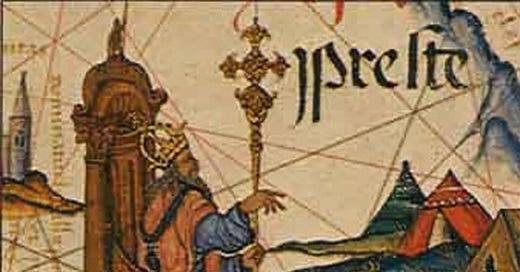In his essay, “The American Myth in Three Anti-American Generations,” Umberto Eco discusses the fascination that Fascists and Communists had with America, despite the official party line against capitalism. He particularly notes how Italian writers were able to better see their own culture after having discovered American culture in the writings of John Steinbeck and Sinclair Lewis.1 Even when actively looking to shed the traditions of the past, individuals find the task more difficult than imagined. Eco experiences this phenomenon when considering the influence of Jorge Luis Borges upon his own writings.2 The Postmodern desire to be original nagged at him, but he found upon reflection that these influences are unavoidable, and in truth, they are also a good thing connecting Eco to the past. He stands out as a consummate reminder of old things, and he expresses in the written word a strange amalgamation of change and tradition, of the beautiful and the disturbed.
Eco inhabits the Postmodern world, but his writings hearken back to a period that seems as foreign as one can imagine. As he explains of literature: “Apart from many important aesthetic reasons, I think that we read novels because they give us the comfortable sensation of living in worlds where the notion of truth is indisputable, while the actual world seems to be a more treacherous place.”3 Eco understands how to play the game of fiction, and how to translate that into the passing on of moral truths which connect the reader to the past. In order to craft a work of fiction which might withstand the Postmodernity of Eco’s critique, the writer must square a few oppositional things: he must have an historical grounding, an integrated approach to tradition, and a religious component that answers important questions for the characters. Eco does this with his 2002 publication of Baudolino.
Eco places the story of Baudolino during major historical events that are well attested by the historical record. The story takes place during the reign of Frederick Barbarossa, involving the actual controversy surrounding the letters of Prester John which happened during Barbarossa’s time as emperor.4 In fact, all of the characters in Baudolino are based upon historical figures, bearing their names and generalized roles faithfully.5 The character of Baudolino is a man out of his time, often voicing postmodern views in the face the medieval reality around him. Even his initial conversation wherein he explains the need to forge the letter from Prester John smacks of the sort of Derridean remarks that one would expect from a twenty-first century philosophy student.6 Eco’s Baudolino is a postmodern man trying to make sense of the medieval world. With the emergence of the genuine map, Baudolino and his friends cease to strive for an imagined realm of Prester John, embarking on a journey out of the mundane and into the fantastical.7 The placement of these moments serve as the proper catalysts to move the primary actors towards a recognition of the Divine. For Baudolino, the disenchanted world of Constantinople holds no promises for him, and he resolutely sets about returning to the mythical realm of Prester John, hopeful that this world will take him in all of his fallenness.8 Baudolino discovers the truth of his earlier musings, “that, imagining other worlds, you end up changing this one.”9 Baudolino has lived a life of lies, but his encounter with the supernatural has given him a new perspective on truth, one that no longer depends upon his own inventiveness bur is rather anchored in the real world (fantastic though it may be).
While Baudolino’s story may not seem obvious, one thing that is clear is that the loss of his friends and loved ones stems largely from Baudolino’s abuse of his religion.10 As Baudolino confesses the truth, finds himself stoned for it, and takes up the life of an ascetic, all that he had previously mocked becomes the mode of his redemption. His final act in the novel, his effort to honor promises made long before, is the final characterization of a man undone when his world collided with his own sinfulness. For Baudolino, his redemption lay in a genuine effort to finally find the kingdom of Prester John.
Eco fought against the uneasiness of Postmodernity that gave rise to much of his thought and study. Baudolino may have been a liar, but in the end, he proved an honest one at that.
Umberto Eco, On Literature, trans. Martin McLaughlin (Orlando, FL: Harcourt, Inc., 2004), 255-256 (hereafter abbreviated OL).
Ibid., 134-135.
Umberto Eco, Six Walks in the Fictional Woods (Cambridge: Harvard University Press, 1994), 91.
Raffaele De Benedictis, “That History Which Is Not in Umberto Eco’s Baudolino,” Forum Italicum 36, no. 2 (September 2002): 393-394.
Sabine Mercer, “Truth and Lies in Umberto Eco’s Baudolino,” Philosophy and Literature 35, no. 1 (April 2011), 20. Mercer claims that Baudolino’s friends are also fictional. However, even those characters, such as the Archpoet and Kyot, have some basis in reality with their sources stemming from medieval legend.
Umberto Eco, Baudolino: A Novel, transs William Weaver (Orlando, FL: Harcourt, Inc., 2002), 98.
Eco, Baudolino, 327. Using Euclid’s method, the Golden Ratio is represented by the number 1.618. This is calculated as 1.596 using Euclid’s formula.
Eco, Baudolino, 518-519. Significantly, this is the first (and last) scene in the novel that suggests Baudolino has finally come to understand his own sinful nature, and it begins with his rejection of the lies and deceitfulness of his past lifestyle. He embraces the truth, even if it means his death.
Eco, Baudolino, 99.
Eco, Baudolino, 511.







Thank you for this! I literally bought “Baudolino” YESTERDAY! We are really enjoying your Substack. 🤓
Six walks 😍